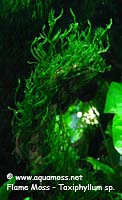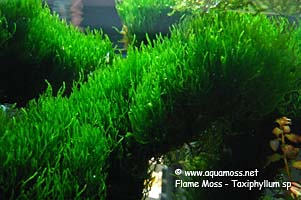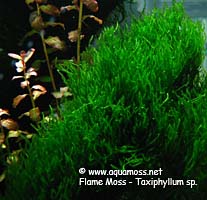Many new hobbyists see pictures of beautiful planted aquaria in books and magazines, and they immediately envision the same thing in their living rooms. They then begin doing research online and are overwhelmed with information and advice on websites and forums. They read that in order to have such a beautiful tank, they have to spend hundreds or even thousands of dollars on specialized lighting, CO2 injection systems, pH controllers, specialized filters, undergravel cable heating and test kits.
Click image to enlarge

Java moss (Vesicularia dubyana) attaches to any surface and grows in low light. Trimming is necessary with this plant, as it grows profusely. |

Several plants will easily grow in a low-tech plant tank. All that is necessary are good substrate and about 1.5 watts of full-spectrum lighting per gallon. |
This often intimidates new planted-aquarium hobbyists, scaring them away not only from the idea of keeping a successful planted tank but from the aquarium hobby itself. The fact is that aquarists have been successfully keeping planted aquaria in their living rooms since the mid-1850s — nearly a generation before the invention of the light bulb and more than a century before the invention of things like pH controllers and CO2 injectors. Don’t get me wrong — these wonderful inventions can help you set up a beautiful planted tank with challenging aquatic plants — but to just have a beautiful, simple and easy-to-maintain aquarium in the living room, none of them are necessary.
I speak from personal experience here. I have maintained planted aquaria for more than 35 years. I currently have nearly 75 planted tanks, and only a few of them have CO2 injection. None have any other high-tech gadgets. It is true that I could not maintain plants like Hygrophila balsamica or Bacopa australis in these low-tech tanks, but I don’t need plants like that to enjoy my hobby, either.
What follows is a list of some of my favorite plants. All of them are easy to keep and grow in a low-tech planted tank. All you need are a good substrate that is made of either a mix of dirt and sand covered by a layer of fine gravel or one of the many commercial planted tank substrates, approximately 1.5 watts per gallon of full-spectrum lighting (a double-bulb fixture will do for most tanks), and either a canister or submersible filter that doesn’t churn up the water surface too much.
Click image to enlarge

Make sure not to bury the rhizome when keeping the various types of Anubias. Here, we can see the rhizome, roots and leaves of Anubias barteri. |

An aquatic plant that can be found growing on the edges of streams and around waterfalls in nature is Java fern (Microsorum pteropus). These plants do well when attached to driftwood and other decor. |

Sagittaria species grow in rosettes, which produce young plants off of a runner. The runners can create chains, causing these plants to sometimes be called pygmy chain swords. |

The grassy-looking Vallisneria is often used to create thickets framing the aquarium. They grow by runners, which are shown here on this V. nana. |
Anubias
Plants from the genus Anubias are beautiful, hardy marsh plants from African jungle streams. They are adapted to shade and seasonal fluctuations in water levels, so they are incredibly hardy. I liken them to living plastic plants — they are almost impossible to kill! The various subspecies of A. barteri are the most frequently encountered, and all of them are excellent plants for the low-tech beginner’s tank.
The secret to success is to not bury the rhizome, the thick, fleshy basal stem from which the leaves grow upward and the roots grow downward. These plants do well attached to driftwood. I often simply wriggle the roots into holes in the driftwood and let the plant grow from there. Old leaves sometimes begin to grow algae on their edges. I cut these leaves off.
Java Moss
This versatile moss is hardy and beautiful. It will attach itself to any surface. Many aquarists attach it to their foam or cork backgrounds (not the glass) using staples, pins or string. This forms a living wall along the back of the tank. It will grow in extremely low light, and it provides plenty of hiding places for eggs, young fish and fish on the smaller side. Java moss grows profusely and will need to be trimmed back on occasion.
Java Fern
This group of aquatic ferns usually grows along the edges of streams in the wild and is often found growing on rocks along and even under waterfalls. Attach it to driftwood, rocks and other ornaments using black cotton thread loosely wrapped around the rhizome and the item to which it will be attached. There are several varieties: some with long, thin leaves; others with short, wide leaves; and still others with intricate lacy, branching leaves. All are cultivated in a similar manner and will do well with as little as 1 watt of light per gallon. Do not bury their “roots” but rather attach them to something above the substrate, such as rocks or driftwood.
Sagittaria
These beautiful bright green grasslike plants make excellent foreground, mid-ground or background plants, depending on the species. They grow in rosettes, and each rosette will send off a runner that will produce a young plant. Often these runners form chains, giving rise to one of their common names: pygmy chain sword. They form bright green clumps or thickets that contrast well in color and shape with other plants mentioned in this article.
Vallisneria
These darker green grasslike plants are often used along the back or sides of a tank to form thickets to frame the rest of the tank. They also grow by runners, but some larger varieties will grow to the surface and even lay across the surface, shading out other plants. These larger varieties should be avoided in favor of shorter corkscrew or nana (Vallisneria nana) varieties.
A mix of these easy-to-grow plants will provide beginning aquarists with a beautiful, long-lasting and easy low-light planted tank that will give them pleasure for many years to come. You can enjoy a planted tank without all of the hassles of constant tweaking, measuring, charting and trimming that come along with high-tech planted tanks. If you want a planted tank but don’t want all of the work, give these simple beauties a try.










